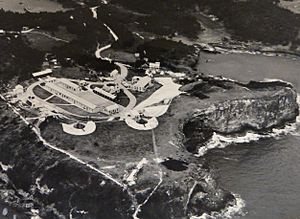ARC Antioquia (1932) facts for kids
ARC Antioquia was a type of warship called a destroyer that belonged to the Colombian Navy. It was built in the 1930s and was one of two ships in its class. Antioquia was originally ordered by the Portuguese Navy but was bought by Colombia while it was still being built. The ship served for many years before it was taken out of service in 1960 and later taken apart for scrap metal.
Quick facts for kids History |
|
|---|---|
| Name | Antioquia |
| Namesake | Antioquia Department |
| Builder | Lisbon Shipyard |
| Launched | 10 May 1933 |
| Acquired | 1933 |
| Commissioned | 24 February 1934 |
| Decommissioned | 25 October 1960 |
| Refit | 1954 |
| Fate | Scrapped, November 1961 |
| General characteristics (as built) | |
| Class and type | Antioquia-class destroyer |
| Displacement | |
| Length | 323 ft (98.5 m) |
| Beam | 31 ft (9.4 m) |
| Draught | 11 ft (3.4 m) |
| Installed power | |
| Propulsion | 2 shafts; 2 × geared steam turbines |
| Speed | 36 knots (67 km/h; 41 mph) |
| Range | 5,400 nmi (10,000 km; 6,200 mi) at 15 knots (28 km/h; 17 mph) |
| Complement | 147 |
| Armament | |
Contents
Ship Design and Features
The Antioquia-class ships were designed by a British company called Yarrow Shipbuilders. Their design was based on a prototype destroyer named Ambuscade, which was built for the Royal Navy in 1926.
Size and Movement
The Antioquia was about 323 feet (98.45 m) long, which is longer than a football field. It was 31 feet (9.45 m) wide and sat 11 feet (3.35 m) deep in the water. The ship weighed about 1,219 long tons (1,239 t) when it was empty and 1,563 long tons (1,588 t) when it was fully loaded.
Power and Speed
The Antioquia was powered by two steam turbine engines. These engines used steam from three large Yarrow boilers. The engines were very powerful, giving the ship a top speed of 36 knots (67 km/h; 41 mph), which is about 41 miles per hour. The ship could travel a long distance, about 5,400 nautical miles (10,000 km; 6,200 mi) (over 6,200 miles), when cruising at a slower speed of 15 knots (28 km/h; 17 mph). A crew of 147 officers and sailors worked on the ship.
Weapons and Defense
The ship had several types of weapons to defend itself and attack enemies:
- Four 4.7-inch (120 mm) guns.
- Three 2-pounder (40 mm) anti-aircraft guns to shoot down planes.
- Two sets of four torpedo tubes that could launch 21-inch (533 mm) torpedoes.
- Two depth charge throwers with 12 depth charges to attack submarines.
- It could also carry up to 20 mines to lay in the water.
Building and Service
Antioquia was built in Lisbon, Portugal. It was originally named NRP Douro and was meant for the Portuguese Navy. The design for this ship and five others in its class came from the British company Yarrow Shipbuilders.
In 1933, before it was even finished, the Douro was bought by the Colombian Navy. This happened because of a disagreement between Colombia and Peru, known as the Leticia Incident. The ship was renamed Antioquia after the Antioquia Department in Colombia, which helped pay for it. A sister ship, NRP Tejo, was also bought by Colombia at the same time and renamed ARC Caldas.
The Bermuda Incident
In 1936, Antioquia was involved in a strange event that could have caused a serious problem. When the British King, George V, passed away, a group of soldiers in Bermuda was supposed to fire a special salute. They were meant to fire 70 blank rounds from a large gun, one for each year of the king's life.
However, the soldiers only had 23 blank rounds. For the rest of the salute, they had to use real ammunition, but they aimed the guns far out to sea. What they didn't know was that the Antioquia was sailing towards Bermuda to get repairs. The ship's crew was very surprised to find themselves under fire! Luckily, the ship was not hit, and no one was hurt. It was a big misunderstanding.
Later Years and Retirement
In 1954, both ARC Antioquia and ARC Caldas were updated in the United States. They had three new 5-inch guns added. This change made the ships handle poorly in bad weather and put stress on their hulls.
Antioquia was taken out of service in 1961. The name Antioquia was then given to a different destroyer that had been built for the United States Navy. Today, there is another ship named ARC Antioquia, which is a modern missile-armed frigate.
See Also
- List of ships of the Colombian Navy


